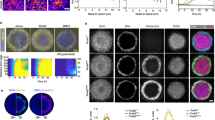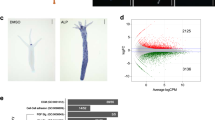Abstract
Embryological and genetic evidence indicates that the vertebrate head is induced by a different set of signals from those that organize trunk–tail development1,2,3,4,5,6. The gene cerberus encodes a secreted protein that is expressed in anterior endoderm and has the unique property of inducing ectopic heads in the absence of trunk structures1. Here we show that the cerberus protein functions as a multivalent growth-factor antagonist in the extracellular space: it binds to Nodal, BMP and Wnt proteins via independent sites. The expression of cerberus during gastrulation is activated by earlier nodal-related signals in endoderm and by Spemann-organizer factors that repress signalling by BMP and Wnt. In order for the head territory to form, we propose that signals involved in trunk development, such as those involving BMP, Wnt and Nodal proteins, must be inhibited in rostral regions.
This is a preview of subscription content, access via your institution
Access options
Subscribe to this journal
Receive 51 print issues and online access
$199.00 per year
only $3.90 per issue
Buy this article
- Purchase on Springer Link
- Instant access to full article PDF
Prices may be subject to local taxes which are calculated during checkout




Similar content being viewed by others
References
Bouwmeester, T., Kim, S. H., Sasai, Y., Lu, B. & De Robertis, E. M. Cerberus is a head-inducing secreted factor expressed in the anterior endoderm of Spemann's organizer. Nature 382, 595–601 (1996).
Thomas, P. & Beddington, R. Anterior primitive endoderm may be responsible for patterning the anterior neural plate in the mouse embryo. Curr. Biol. 6, 1487–1496 (1996).
Shawlot, W. & Behringer, R. R. Requirement for Lim1 in head-organizer function. Nature 374, 425–430 (1995).
Glinka, A., Wu, W., Onichtchouk, D., Blumenstock, C. & Niehrs, C. Head induction by simultaneous repression of Bmp and Wnt signalling in Xenopus. Nature 389, 517–519 (1997).
Glinka, A. et al. Dickkopf-1 is a member of a new family of secreted proteins and functions in head induction. Nature 391, 357–362 (1998).
Harland, R. & Gerhart, J. Formation and function of Spemann's organizer. Annu. Rev. Cell Dev. Biol. 13, 611–667 (1997).
Hsu, D. R., Economides, A. N., Wang, X., Eimon, P. M. & Harland, R. M. The Xenopus dorsalizing factor gremlin identifies a novel family of secreted proteins that antagonize BMP activities. Mol. Cell 1, 673–683 (1998).
Belo, J. A. et al. Cerberus-like is a secreted factor with neuralizing activity expressed in the anterior primitive endoderm of the mouse gastrula. Mech. Dev. 68, 45–57 (1997).
Jones, C. M., Kuehn, M. R., Hogan, B. L. M., Smith, J. C. & Wright, C. V. E. Nodal-related signals induce axial mesoderm and dorsalize mesoderm during gastrulation. Development 121, 3651–3662 (1995).
Piccolo, S. et al. Cleavage of Chordin by Xolloid metalloprotease suggests a role for proteolytic processing in the regulation of Spemann organizer activity. Cell 91, 407–416 (1997).
Feldman, B. et al. Zebrafish organizer development and germ-layer formation require nodal-related signals. Nature 395, 181–185 (1998).
Sampath, K. et al. Induction of the zebrafish ventral brain and floor plate requires cyclops/nodal signalling. Nature 395, 185–189 (1998).
Rebagliati, M. R., Toyama, R., Haffter, P. & Dawid, I. B. cyclops encodes a nodal-related factor involved in midline signaling. Proc. Natl Acad. Sci. USA 95, 9932–9937 (1998).
Varlet, I., Collignon, J. & Robertson, E. J. Nodal expression in the primitive endoderm is required for the specification of the anterior axis during mouse gastrulation. Development 124, 1033–1044 (1997).
Conlon, F. L. et al. Aprimary requirement for nodal in the formation and maintenance of the primitive streak in the mouse. Development 120, 1919–1928 (1994).
Waldrip, W. R., Bikoff, E. K., Hoodless, P. A., Wrana, J. L. & Robertson, E. J. Smad2 signaling in extraembryonic tissues determines anterior-posterior polarity of the early mouse embryo. Cell 92, 797–808 (1998).
Nomura, M. & Li, E. Smad2 role in mesoderm formation, left-right patterning and craniofacial development. Nature 393, 786–790 (1998).
Chang, C., Wilson, P. A., Mathews, L. S. & Hemmati-Brivanlou, A. A Xenopus type I activin receptor mediates mesodermal but not neural specification during embryogenesis. Development 124, 827–837 (1997).
Hoppler, S. & Moon, R. T. BMP-2/4 and Wnt-8 cooperatively pattern the Xenopus mesoderm. Mech Dev. 71, 119–129 (1998).
Leyns, L., Bouwmeester, T., Kim, S. H., Piccolo, S. & De Robertis, E. M. Frzb-1 is a secreted antagonist of Wnt signaling expressed in the Spemann Organizer. Cell 88, 747–756 (1997).
Rhinn, M. et al. Sequential roles for Otx2 in visceral endoderm and neuroectoderm for forebrain and midbrain induction and specification. Development 125, 845–856 (1998).
Bouwmeester, T. & Leyns, L. Vertebrate head induction by anterior primitive endoderm. BioEssays 19, 855–863 (1997).
Henry, G. L. & Melton, D. A. Mixer, a homeobox gene required for endoderm development. Science 281, 91–96 (1998).
Kessler, D. S. & Melton, D. A. Induction of dorsal mesoderm by soluble, mature Vg1 protein. Development 121, 2155–2164 (1995).
Acknowledgements
We thank L. S. Mathews, N. Ueno, R. Moon, D. Melton and K. Cho for gifts of plasmids, K.Masuhara for anti-BMP4 mAb, Genetics Institute for BMPs, and members of the De Robertis laboratory for comments. S.P., E.A., S.B. and H.G were supported by Telethon, ARC, MSTP and DFG, respectively. This work was supported by a grant from the NIH. E.M.D.R. is a Howard Hughes Medical Institute investigator.
Author information
Authors and Affiliations
Rights and permissions
About this article
Cite this article
Piccolo, S., Agius, E., Leyns, L. et al. The head inducer Cerberus is a multifunctional antagonist of Nodal, BMP and Wnt signals. Nature 397, 707–710 (1999). https://doi.org/10.1038/17820
Received:
Accepted:
Issue Date:
DOI: https://doi.org/10.1038/17820
This article is cited by
-
Highly conserved and extremely evolvable: BMP signalling in secondary axis patterning of Cnidaria and Bilateria
Development Genes and Evolution (2024)
-
Efficient differentiation of human embryonic stem cells to retinal pigment epithelium under defined conditions
Stem Cell Research & Therapy (2021)
-
Wnt/β-catenin signaling in cancers and targeted therapies
Signal Transduction and Targeted Therapy (2021)
-
Generation of pancreatic β cells from CD177+ anterior definitive endoderm
Nature Biotechnology (2020)
-
Diversification of amphioxus and vertebrate Cerberus protein function in modulating Nodal, BMP and Wnt signals
Marine Life Science & Technology (2020)
Comments
By submitting a comment you agree to abide by our Terms and Community Guidelines. If you find something abusive or that does not comply with our terms or guidelines please flag it as inappropriate.



